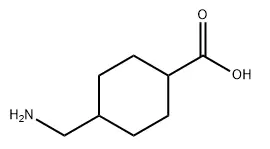How Does Tranexamic Acid Stop Bleeding?
2025-10-24 12:01:54
Controlling bleeding is an important part of medical care, and tranexamic acid is one of the best medicines for this. Pure tranexamic acid powder is particularly valued for its effectiveness in stopping bleeding. Using this man-made chemical has changed the way that many bleeding diseases are treated and surgeries are done. We will talk about how tranexamic acid stops bleeding and all the different ways it is used in modern medicine in this encyclopedic guide.

Tranexamic Acid as an Antifibrinolytic
Tranexamic acid belongs to a class of medications known as antifibrinolytics. These drugs work by preventing the breakdown of blood clots, thereby promoting hemostasis and reducing blood loss. Pure tranexamic acid powder is a key form of this medication used in clinical settings for its potency and effectiveness. To understand how tranexamic acid functions, it's essential to first grasp the concept of fibrinolysis.
Understanding Fibrinolysis
Fibrinolysis is a natural process in the body that breaks down blood clots. While this mechanism is crucial for maintaining normal blood flow and preventing excessive clotting, it can be problematic in situations where rapid clotting is necessary to stop bleeding. This is where antifibrinolytic agents like tranexamic acid come into play.
The Role of Tranexamic Acid in Clot Stabilization
Tranexamic acid works by inhibiting the activation of plasminogen to plasmin. Plasmin is an enzyme responsible for breaking down fibrin, the primary component of blood clots. By preventing the formation of plasmin, tranexamic acid helps maintain the integrity of blood clots, allowing them to persist long enough to effectively stop bleeding.
Mechanisms of Tranexamic Acid in Bleeding Control
The action of tranexamic acid in controlling bleeding is multifaceted and involves several molecular pathways. Pure tranexamic acid powder is widely used for its effectiveness in promoting hemostasis. Let's delve deeper into the specific mechanisms that make this compound so effective in controlling bleeding.
Inhibition of Plasminogen Activation
The primary mechanism of action for tranexamic acid is its ability to inhibit the conversion of plasminogen to plasmin. It achieves this by binding to specific sites on the plasminogen molecule, preventing its interaction with tissue plasminogen activator (tPA). This inhibition effectively reduces the amount of active plasmin available to break down fibrin clots.
Preservation of Fibrin Networks
By reducing plasmin activity, tranexamic acid helps preserve the fibrin networks that form the structural basis of blood clots. This preservation is crucial in maintaining clot stability and preventing premature breakdown, which is especially important in situations of acute bleeding or during surgical procedures.
Modulation of Inflammatory Response
Recent research has suggested that tranexamic acid may also play a role in modulating the inflammatory response associated with tissue injury and bleeding. By reducing the activation of certain inflammatory pathways, it may contribute to improved outcomes in trauma and surgical settings.
Common Uses of Tranexamic Acid
The versatility of tranexamic acid has led to its widespread use in various medical fields. Pure tranexamic acid powder is particularly valued for its quick dissolution and potency, making it a go-to compound in many clinical applications. From emergency medicine to elective surgeries, this compound has proven its worth in numerous clinical scenarios.
Trauma and Emergency Medicine
In trauma care, time is of the essence when it comes to controlling bleeding. Tranexamic acid has become a staple in emergency departments and ambulances worldwide. Its rapid action and effectiveness in reducing mortality in trauma patients with significant bleeding have made it an indispensable tool in emergency medicine.
Surgical Applications
Surgeons across various specialties have incorporated tranexamic acid into their practice to reduce intraoperative and postoperative blood loss. Its use is particularly prevalent in orthopedic surgeries, cardiac procedures, and obstetric interventions. By minimizing blood loss, tranexamic acid can reduce the need for blood transfusions and improve overall surgical outcomes.
Obstetrics and Gynecology
Postpartum hemorrhage remains a significant cause of maternal mortality worldwide. Tranexamic acid has shown remarkable efficacy in reducing blood loss during childbirth and in the treatment of heavy menstrual bleeding. Its use in obstetrics has been associated with improved maternal outcomes and reduced need for invasive interventions.
Dental Procedures
In dentistry, tranexamic acid is often used as a topical agent to control bleeding following tooth extractions or other oral surgeries. Its local application can significantly reduce postoperative bleeding and improve wound healing.
Conclusion
Tranexamic acid has become a very useful medicine for many types of doctors to use when someone is bleeding. Because it stops fibrinolysis and keeps blood clots stable, it is very useful for both short-term and long-term bleeding. Tranexamic acid is expected to play a bigger role in medicine as more research is done to find new uses and better ways to dose it.
What tranexamic acid does to stop bleeding is a great example of how focused pharmaceutical interventions can help with serious medical problems. As doctors keep working to make the best use of it, patients all over the world will be able to have better results and fewer problems with bleeding disorders and surgeries.
FAQ
1. What is Tranexamic Acid Powder?
Tranexamic Acid Powder, also known by its generic name Tranexamic Acid (TXA) and CAS number 1197-18-8, is a synthetic amino acid derivative primarily used as an antifibrinolytic agent. It has the chemical formula C8H15NO2 and a molecular weight of 157.21 g/mol. This powder is freely soluble in water and glacial acetic acid but practically insoluble in acetone and ethanol. Tranexamic acid powder is used clinically to control bleeding, particularly in surgical procedures and postpartum cases, due to its ability to inhibit the breakdown of fibrin clots.
2. What are the benefits of Tranexamic Acid Powder?
Effective Hemostasis: Tranexamic Acid Powder is highly effective in controlling bleeding by inhibiting the fibrinolytic system. This makes it a valuable tool in various medical scenarios, including major surgeries and postpartum hemorrhage. Reduction in Blood Loss: By inhibiting fibrinolysis, TXA reduces blood loss during and after surgery, which can lead to fewer complications and faster recovery times. Improved Survival Rates: Studies, such as the CRASH-2 trial, have shown that early administration of tranexamic acid powder can significantly reduce the risk of death in trauma patients with severe bleeding. Versatile Applications: Tranexamic Acid Powder can be used in a variety of settings, including emergency rooms, operating rooms, and obstetrics departments, making it a versatile addition to the medical arsenal. Cost-Effective: Compared to newer hemostatic agents, tranexamic acid powder is often more affordable, making it a cost-effective option for healthcare providers.
3. What are the dosage of Tranexamic Acid Powder?
Adult Dosage for Bleeding Control: The recommended dosage for adults to control bleeding is typically an initial intravenous bolus of 1g followed by an infusion of 1g over 8 hours. This dosage can be adjusted based on the patient's response and the severity of the bleeding. Dosage Adjustments: Dosage adjustments may be necessary in patients with renal impairment or those at high risk for thrombosis. Close monitoring of coagulation parameters and clinical response is recommended. Duration of Therapy: The duration of therapy with tranexamic acid powder depends on the underlying cause of the bleeding and the patient's response to treatment. Therapy should be discontinued once bleeding is controlled and the patient is stable. Route of Administration: Tranexamic acid powder is typically administered intravenously for rapid onset of action. However, oral formulations are also available for certain indications. Monitoring and Follow-Up: Regular monitoring of coagulation parameters, vital signs, and clinical response is essential during therapy with tranexamic acid powder to ensure safety and effectiveness.
Discover the Power of Pure Tranexamic Acid Powder with YTBIO
Are you in search of a reliable and high-quality pure tranexamic acid powder supplier? Look no further than YTBIO. As a leading provider of organic and plant-based ingredients, we offer premium-grade tranexamic acid powder that meets the highest standards of purity and efficacy.
At YTBIO, we understand the critical role that tranexamic acid plays in modern medicine. That's why we've dedicated ourselves to producing this vital compound with uncompromising quality. Our state-of-the-art facilities and rigorous quality control processes ensure that every batch of our pure tranexamic acid powder meets or exceeds industry standards.
Whether you're a pharmaceutical company, a research institution, or a healthcare provider, YTBIO has the expertise and capacity to meet your tranexamic acid needs. Our commitment to excellence, combined with our competitive pricing and reliable supply chain, makes us the ideal partner for your medical and scientific endeavors.
Don't settle for anything less than the best when it comes to such a crucial component in bleeding control. Choose YTBIO for your pure tranexamic acid powder supply and experience the difference that quality and reliability can make.
To learn more about our pure tranexamic acid powder and other high-quality organic ingredients, contact our expert team today at sales@sxytorganic.com. Let YTBIO be your trusted partner in advancing healthcare and scientific research.
References
1. Shakur, H., et al. (2010). Effects of tranexamic acid on death, vascular occlusive events, and blood transfusion in trauma patients with significant haemorrhage (CRASH-2): a randomised, placebo-controlled trial. The Lancet, 376(9734), 23-32.
2. Ker, K., et al. (2012). Effect of tranexamic acid on surgical bleeding: systematic review and cumulative meta-analysis. BMJ, 344, e3054.
3. Collaborators, W. M. T. (2017). Effect of early tranexamic acid administration on mortality, hysterectomy, and other morbidities in women with post-partum haemorrhage (WOMAN): an international, randomised, double-blind, placebo-controlled trial. The Lancet, 389(10084), 2105-2116.
4. McCormack, P. L. (2012). Tranexamic acid: a review of its use in the treatment of hyperfibrinolysis. Drugs, 72(5), 585-617.
5. Dunn, C. J., & Goa, K. L. (1999). Tranexamic acid: a review of its use in surgery and other indications. Drugs, 57(6), 1005-1032.
6. Roberts, I., et al. (2011). The importance of early treatment with tranexamic acid in bleeding trauma patients: an exploratory analysis of the CRASH-2 randomised controlled trial. The Lancet, 377(9771), 1096-1101.
_1737093401309.png)
